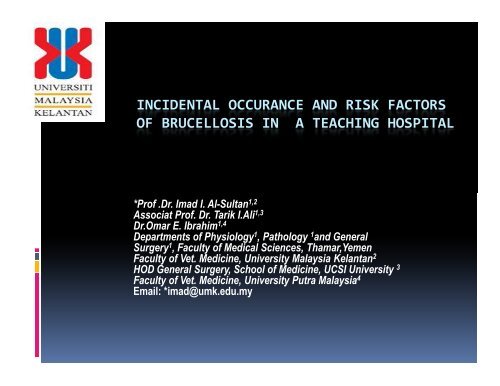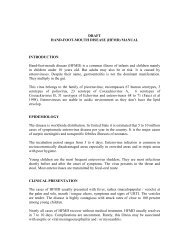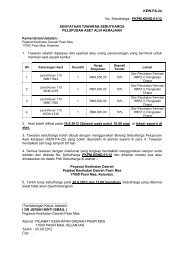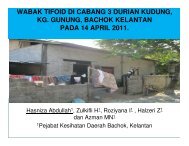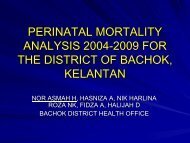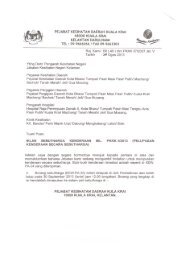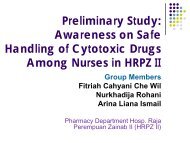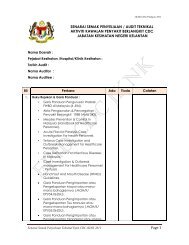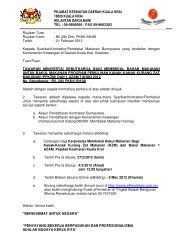Brucella - JKN Kelantan
Brucella - JKN Kelantan
Brucella - JKN Kelantan
Create successful ePaper yourself
Turn your PDF publications into a flip-book with our unique Google optimized e-Paper software.
INCIDENTAL OCCURANCE AND RISK FACTORS<br />
OF BRUCELLOSIS IN A TEACHING HOSPITAL<br />
*Prof .Dr. Imad I. Al-Sultan 1,2<br />
Associat Prof. Dr. Tarik I.Ali 1,3<br />
Dr.Omar E. Ibrahim 1,4<br />
Departments of Physiology 1 , Pathology 1 and General<br />
Surgery 1 , Faculty of Medical Sciences, Thamar,Yemen<br />
Faculty of Vet. Medicine, University Malaysia <strong>Kelantan</strong> 2<br />
HOD General Surgery, School of Medicine, UCSI University 3<br />
Faculty of Vet. Medicine, University Putra Malaysia 4<br />
Email: *imad@umk.edu.my
Brucellosis is an important<br />
public health problem in<br />
developing countries and<br />
represent a health problem in<br />
Yemen.
. Brucellosis is an infectious worldwide re-emerging disease of<br />
zoonotic nature caused by bacteria of the genus brucella.<br />
The disease have several entities like( undulant fever, Malta<br />
fever, Mediterenian fever, Ypres fever and Milk sickness).<br />
Its primarily a disease of domestic animals (Wilkiness,1993).<br />
Man infected by direct animal contact or with contaminated<br />
animal products consumed (Malhota,2004).
<strong>Brucella</strong> species can cause disease in man like<br />
B.melitensis,B.suis,B.abortus and B.canis.<br />
<strong>Brucella</strong> spp. are dangerous infectious bacteria listed<br />
among CDC's category B bioterrorism agents.<br />
Bacterial species originally found in brucellosis cases of sheep<br />
and gout,pig,cattle, and dog respectively (Ettinger,1995).<br />
Epidemiological studies confined to incidence and distribution of<br />
the disease reported as very high in Saudi Arabia,Oman,and<br />
Kuwait but none in Bahrain(Refai,2002).
In Yemen, animal Brucellosis is an endemic disease.<br />
Prevalence rate of disease in man reported among microbiological<br />
study 24.5% (Alshamahy,2002).<br />
Disease transmition through contaminated milk , or direct contact<br />
with infected animals or by occupational workers with (placenta,<br />
slaughter, carcass) (malhotra,2004).<br />
Breathing (inhalation) May play role in transmission.
Contamination of skin wounds or abrasions is the problem of persons who work in<br />
slaughter houses (butchers) or in the fields of veterinary practice (sheriff,1998).<br />
Direct person to person spread of brucellosis is extremely rare.<br />
Mothers who are breast feeding may transmit the infection to their infants.<br />
Sexually transmission also have been reported.<br />
Uncommon transmission may also occur via contaminated tissue (tulian, 2007).
Brucellosis in humans is a multisystem disease manifested with acute febrile<br />
condition .Brucellosis initially results in flu-like symptoms .<br />
The duration of disease can vary from a few weeks to many months or years.<br />
Patients with brucellosis may present with an acute or insidious fever, sweating,<br />
weakness, anemia, headache, muscular and bodily pain, joint pain, lethargy and<br />
depression (Wilkinson, 1993).
Other clinical symptoms are, hepatomegaly, lymphadenopathy and gastrointestinal<br />
trouble.<br />
Untreated cases properly develop complication such as arthritis in about 30% of cases ,<br />
spontaneous abortion of pregnant woman, and gastrointestinal complications ( ascetic,<br />
diarrhea ,hepatic failure) (nashir,2006).<br />
Genitourinary infection such as orchitis and epididymitis leading to infertility is another<br />
important outcome.
Study Objectives<br />
Identify the incidence of brucellosis patients hospitalized at a<br />
teaching hospital.<br />
Analyze the demographic features of brucellosis patients<br />
hospitalized between January 2005 and December 2007.
Materials and Methods<br />
• Inpatients confirmed by physicians’ diagnosis as brucellosis by the aid<br />
of serology and bacteriology lab. Tests.<br />
• Information taken from patients after filling questionnaires.<br />
• Data analyzed by standard statistical procedures.<br />
• Cases screened to illustrate the percentages rates of brucellosis (2000-<br />
2007) were 520.<br />
• Cases analyzed to determine the demographic features of patients<br />
(2005-2007) were 212.
RESULTS<br />
Number of brucellosis cases at teaching hospital (2000 -2007)
Annually percentage of brucellosis<br />
infected cases in the teaching<br />
hospital(2000-2007)
Brucellosis infected inpatients monitored at the years 2005-<br />
2007 was 212 cases, with incidence rate of 16 /1000 of total<br />
admission.<br />
Females were 124 cases (58.5%) while the males 88 case<br />
(41.5%).<br />
The male to female ratio was (1:1.3).<br />
Patients mean length stay at hospital was 8 days.
22.2%<br />
21.7%<br />
19.4%<br />
16%<br />
10.8%<br />
6.1%<br />
Sociodemographic features extracted from questioners and personal<br />
interaction with hospitalized cases indicates that mean of age groups was 25<br />
years while median was 14 years and representing a standard deviation of 5<br />
years age.<br />
3.8%<br />
> 60 years<br />
51-60 years<br />
41-50 years<br />
31-40 years<br />
Percentage rates of brucellosis cases according to<br />
occupation in the period (2000-2007)<br />
20.3% diary production 6.1% drinking milk<br />
13.7% not known 5.7% housewife<br />
11.7% breading cattle 3.3% others<br />
9.8% butchers<br />
8.5% sheepherder<br />
7.1% health workers<br />
7.1% farmers<br />
6.6% students
68.4%<br />
Patients of brucellosis who reside at the rural areas are more<br />
in number than those who live in urban areas.<br />
31.6%<br />
urban areas<br />
Rural areas
The onset of infection and appearance of symptoms showed a seasonal<br />
pattern with highest incidence at the spring time.
It is recommended that<br />
Successful prevention of human’s brucellosis dependent on prevention of<br />
animal brucellosis.<br />
Highly important to adopt health education programmes to focus on risk<br />
factors and mothers infection .<br />
Performing a case control study and using vaccination to stop spread of<br />
infection.
Thanks for listening


